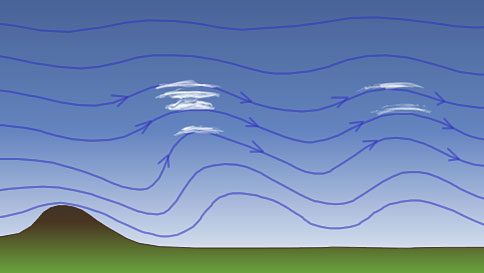|
Irisation in Altocumulus Lenticularis - Wave clouds imaged by Chris
Grohusko of El Paso Texas.
Lenticular clouds are mostly found in the lee of hills and mountains.
They are good sources of iridescence because the droplets in them
have very short lives and have no time to evolve into a range of
different sizes..
The clouds stay in the same position but air is rushing through
them. When air is forced across a mountain it has to rise and then
fall again. Under some atmospheric conditions this induces a whole
series of waves downwind of the mountain.
An air pocket rising with one of the waves expands as it climbs
because the atmospheric pressure falls with height. The adiabatic
expansion causes the air to cool and its water vapour condenses
into a host of small, fresh droplets. A few instants later the air
starts to descend and the downwind edge of the cloud is reached.
The air is compressed as it is forced downwards, it heats up and
the droplets evaporate - end of cloud.
Lenticular clouds are thus very dynamic objects marking the crests
of atmospheric waves and the boundaries of droplet condensation
and evaporation.
Nacreous
clouds much higher in the stratosphere
are also gravity wave clouds.
.
|


